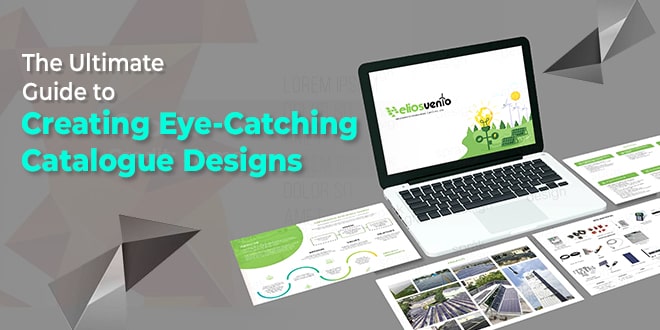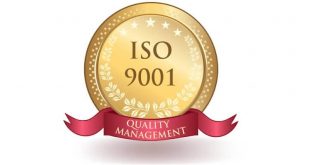Enhance your catalogue designs with our comprehensive guide, Discover the secrets to creating eye-catching designs in this ultimate resource.
In the competitive world of digital marketing and e-commerce, grabbing your audience’s attention is a challenge. To stand out, businesses are relying on expert catalogue design companies to create captivating catalogue that not only showcase products but also narrate their brand story.
This guide delves into catalogue design essentials and the benefits of partnering with a catalogue design company for enhanced brand visibility and increased sales.
What Is Catalogue Design?
Catalogue design is a creative process that focuses on crafting a visually captivating and well-structured catalog to showcase products or services.
This art form involves meticulously combining various design elements such as layout, imagery, typography, and branding to create a cohesive and appealing presentation.
The primary goal of catalogue design is to effectively communicate information about the products or services offered, entice potential customers, and ultimately drive sales. A well-designed catalog not only informs but also engages and inspires the audience.
Types of Catalogues
Print Catalogues
Print catalogues are physical, tangible publications that customers can hold and flip through. They are often used for direct mail marketing, handed out at events, or placed in retail locations.
Design considerations for print catalogues include choosing paper quality, print techniques, and ensuring that the layout translates well to the printed medium.
Digital Catalogues
Digital catalogues are designed for online viewing, often as PDFs or interactive web-based versions. They can include multimedia elements like videos, hyperlinks, and animations. Digital catalogues require considerations for screen compatibility, user experience, and file formats.
E-commerce Catalogues
Online shopping platforms. They integrate product listings with the ability to make purchases directly through the catalogue. Designing e-commerce catalogues involves creating user-friendly interfaces, optimizing for mobile devices, and ensuring seamless integration with the online shopping process.
Target Audience Analysis
Understanding your target audience is the foundation of effective catalogue design. This analysis involves researching and profiling the demographic, psychographic, and behavioral characteristics of your potential customers. Here’s how it influences the design process:
- Content Relevance: By knowing your audience’s preferences and needs, you can select products or services to feature in the catalogue that are most likely to appeal to them. This ensures that your catalogue content is relevant and engaging.
- Visual Style: The design’s visual elements, such as colors, imagery, and typography, should align with the tastes and preferences of your target audience. For instance, a catalogue targeting a youthful demographic may use vibrant colors and trendy fonts.
- Tone and Messaging: Tailoring the language, tone, and messaging to resonate with your audience is crucial. The tone can be formal, casual, informative, or persuasive, depending on your audience’s expectations.
- Layout and User Experience: The layout of the catalogue should facilitate an easy and intuitive browsing experience for your target audience. If your audience consists of tech-savvy individuals, you may incorporate interactive features for a more engaging experience.
Key Elements of Eye-Catching Catalogue Designs
Now that you’ve chosen the right design company, let’s delve into the key elements that make catalogue designs visually appealing and effective.
Cover Design
The cover is the first impression of your catalogue. It should be captivating, featuring high-quality images and compelling titles that entice readers to explore further.
Layout and Organization
A well-structured layout with grids, columns, and an appropriate use of typography enhances readability and aesthetics. Consistency in layout throughout the catalogue is essential.
High-Quality Imagery
Invest in professional product photography and ensure that images are edited and enhanced to perfection. Crisp, clear visuals are non-negotiable.
Color Schemes
Select a harmonious color palette that reflects your brand identity. Consistency in color usage throughout the catalogue creates a cohesive look.
Branding Elements
Incorporate your logo and branding elements consistently to reinforce brand recognition. Consistency across all marketing materials is key.
Content Creation for Catalogues
While design is critical, the content plays an equally important role in engaging your audience and driving conversions.
Writing Engaging Product Descriptions
Craft product descriptions that not only inform but also evoke emotions and highlight the benefits of your offerings.
Using Persuasive Copywriting Techniques
Utilize persuasive language, such as power words and storytelling, to compel readers to take action.
Storytelling in Catalogue Descriptions
Narrative-driven content can create a deeper connection with your audience. Share stories about your products and brand.
Call to Actions (CTAs)
Include clear and compelling CTAs that guide readers towards making a purchase or taking the desired action.
Designing for Different Catalogue Types
Catalogues come in various formats, and designing for each type requires distinct considerations.
Print Catalogues
Select appropriate page sizes and layouts for print catalogues. Ensure that the design is print-friendly, and consider factors like paper quality.
Digital Catalogue Designs
Digital catalogues may include interactive features and must be mobile-friendly for a seamless user experience.
E-commerce Catalogue Designs
For e-commerce catalogues, integration with online shopping platforms and SEO optimization are essential for driving online sales.
Choosing the Right Catalogue Design Company
Creating an eye-catching catalogue is a collaborative effort, and partnering with a professional catalogue design company can make all the difference.
Researching Catalogue Design Companies
Start by researching and identifying potential design companies that specialize in catalogue design. Look for those with a strong track record and a diverse portfolio.
Evaluating Portfolio and Experience
Review their past catalogue design projects to assess their style and expertise. An experienced company is more likely to deliver a design that aligns with your vision.
Checking Client Reviews and Testimonials
Client feedback and testimonials can provide valuable insights into a design company’s professionalism, communication, and ability to meet deadlines.
Budget Considerations
Discuss your budget upfront and ensure it aligns with the services offered by the design company. While quality matters, it’s essential to find a balance that fits your financial constraints.
Tips for a Smooth Collaboration with a Catalogue Design Company
A successful partnership with a design company involves effective communication and collaboration.
- Setting Clear Objectives and Expectations: Define your goals and expectations from the beginning to ensure both parties are aligned.
- Communication and Feedback: Maintain open communication channels and provide constructive feedback throughout the design process.
- Timelines and Deadlines: Establish clear timelines and deadlines to keep the project on track and avoid unnecessary delays.
- Flexibility and Revisions: Be open to revisions and adjustments as the design evolves. Flexibility can lead to a better end result.
Catalogue Design Trends to Consider
To stay ahead of the competition, keep an eye on emerging design trends.
- Minimalistic Design: Minimalism is a popular trend, focusing on simplicity and clean aesthetics.
- Sustainable and Eco-Friendly Catalogues: Consumers appreciate environmentally conscious brands. Consider sustainable materials and printing processes.
- Augmented Reality (AR) Integration: AR can provide an interactive and immersive experience, allowing customers to visualize products in real-life settings.
- Video Content in Catalogues: Incorporate video content to showcase products in action and engage viewers in a dynamic way.
Conclusion: Catalogue Designs
Creating eye-catching catalogue designs is an art and science. Collaborating with a professional catalogue design company can transform your vision into a compelling reality.
By understanding the basics, choosing the right partner, and focusing on key design elements and content, you can create catalogues that not only capture attention but also drive sales. Stay updated with design trends and continuously measure your catalogue’s impact to refine your future efforts.
In the competitive landscape of today, your catalogue can be your brand’s secret weapon. Don’t underestimate the power of a well-designed catalogue in making a lasting impression on your audience and boosting your business’s bottom line.
 Free Web Resources , psd, mockups, & web templates Best WordPress Themes & Best Html Templates
Free Web Resources , psd, mockups, & web templates Best WordPress Themes & Best Html Templates








